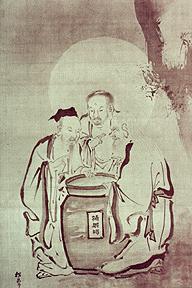The Tao of Pooh facts for kids
 |
|
| Author | Benjamin Hoff |
|---|---|
| Illustrator | Ernest H. Shepard |
| Language | English |
| Genre | Taoism, Philosophy |
| Publisher | Dutton Books |
|
Publication date
|
1982 |
| Pages | 158 |
| ISBN | 0-525-24458-1 |
| OCLC | 8031952 |
| Followed by | The Te of Piglet |
The Tao of Pooh is a famous book written by Benjamin Hoff. It helps people in Western countries learn about Taoism, an ancient Eastern way of thinking. The book uses the beloved characters from A. A. Milne's Winnie-the-Pooh stories to explain the main ideas of Taoist philosophy.
This book was very popular. It stayed on the New York Times bestseller list for 49 weeks! Benjamin Hoff later wrote another book called The Te of Piglet, which is a follow-up to The Tao of Pooh.
Contents
How the Book Was Made
Benjamin Hoff wrote The Tao of Pooh during his free time. He worked on it at night and on weekends. At the time, he was a tree pruner. He worked in the beautiful Portland Japanese Garden in Washington Park in Portland, Oregon.
Understanding Taoism with Pooh
The book starts by talking about something called "The Vinegar Tasters." This is a famous painting. It shows three important thinkers from the East: Confucius, the Buddha, and Laozi. They are all tasting vinegar from a big pot.
Each person reacts differently to the vinegar, which represents life. Confucius finds it sour. The Buddha finds it bitter. But Laozi, who is seen as the founder of Taoism, finds it satisfying. This story helps explain the different ways people view life.
Benjamin Hoff uses Winnie-the-Pooh and his friends to explain Taoist ideas. He writes as if he is talking to these characters. He also includes parts from Milne's original books, Winnie-the-Pooh and The House at Pooh Corner. These parts help show what he means.
Characters and Their Meanings
Hoff uses many of Milne's characters to show different ideas. Some characters represent Taoist ideas, while others show ways of thinking that are not Taoist.
- Winnie-the-Pooh: Pooh himself is a great example of Taoist principles. He shows wu wei, which means "effortless doing." This is about letting things happen naturally without forcing them. He also shows p'u, which means being open to new experiences without being weighed down by them. Pooh's simple nature and natural way of solving problems are perfect examples of Taoist thinking.
- Owl and Rabbit: These characters often make problems more complicated than they need to be. They tend to overthink everything, which can lead to confusion.
- Eeyore: Eeyore is a very pessimistic character. He complains a lot and worries about everything. He struggles to just "be" in the moment.
Hoff believes that Pooh's simple way of looking at the world and his natural instincts are very close to the core ideas of Taoism. The book also includes parts from important Taoist writings by thinkers like Laozi and Zhuang Zhou.
Getting Copyright Back
In April 2018, Benjamin Hoff sent a letter to his publisher. He told them he planned to get the copyright for The Tao of Pooh back. This happened on December 15, 2018.
He explained that he felt his publisher had not treated him well. He also felt they did not properly recognize his achievements. He used updated U.S. Copyright Law to help him get his rights back. Hoff was successful in getting the copyright back. He even shared all the letters and messages about this process on his own website.


